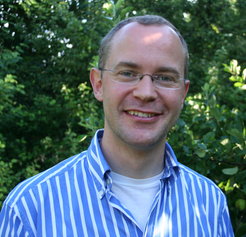Understanding the cosmos
The Swedish mathematician Hans Ringström uses the Prize from the Humboldt Foundation for a research stay at the Max Planck Institute for Gravitational Physics.
Starting this August, Dr. Hans Ringström, one of the leading junior scientists in mathematical relativity, will stay for eleven months at the Max Planck Institute for Gravitational Physics (Albert Einstein Institute, AEI) in Potsdam and at the Freie Universität Berlin. His residency has been made possible by the Alexander von Humboldt Foundation, which has awarded him a Friedrich Wilhelm Bessel Research Prize in recognition of his fundamental work on the Big Bang and on the expansion of outer space.

Hans Ringström, who was born in Stockholm in 1972, combines physics with precise mathematical analysis: the scientist studies physical models for their mathematical consistency. That is particularly important for the description of cosmological phenomena such as, for example, the Big Bang, which cannot be directly observed.
“The Berlin-Potsdam region is exactly the right place for my scientific work,” says Hans Ringström, researcher in mathematical cosmology at the Royal Institute of Technology (KTH) in Stockholm. “Here, I am in a creative milieu where I can work together with both mathematicians and physicists. I am very pleased that the prize from the Alexander von Humboldt Foundation will provide me with the opportunity to intensify my cooperation with the Albert Einstein Institute and with the Freie Universität Berlin.” At the AEI, Hans Ringström will work closely with Dr. Lars Andersson and Dr. Alan Rendall from the ‘Geometric Analysis and Gravitation’ Department.
Background information
Einstein’s cosmos from a mathematical standpoint
Einstein’s general theory of relativity describes the interactions between the structure of space-time and matter. The key idea of general relativity is to not look at gravity as a force, but as a characteristic of the geometry of space and time. Space-time is dynamic, is distorted by any matter contained in it, which in turn tells matter how to move and evolve. Einstein’s theory is formulated in the language of geometry and analysis, especially by means of differential geometry and partial differential equations. Hans Ringström studies these gravitational field equations and then postulates about the behaviour of their general solutions. His results are particularly remarkable because they are not limited to only a few special cases, but have general validity.
Dark energy
Around ten years ago, our image of the cosmos underwent a decisive change. Back then, it was discovered that space was not only expanding, but that this expansion was happening at an ever-faster pace. This proves the existence of a repelling force that is driving the universe apart at accelerating speed. The cause of this force - so-called ‘dark energy’ - is unknown and represents one of the biggest mysteries in modern physics.
Hans Ringström studied the solutions of Einstein’s equations taking dark energy into consideration and has proven that these solutions develop in the general case in the same manner as is known from astronomical observations: the tempo of expansion is increasing. As the field equations of general relativity are so complicated, such generally applicable assertions are very rarely encountered and thus an extremely important result.
The mathematics of the Big Bang
Certainly one of the most dramatic consequences of Einstein’s description of gravity by means of curved space-time geometry is the possibility that space and time could have “holes” or “edges”: so-called space-time singularities. When singularities arise, particles, for example, can abruptly disappear or just as suddenly appear from nowhere. An amazing prediction! It is therefore important to research under which conditions that occurs - after all, this assertion of the theory would be very disturbing when they also apply to the “normal case”, for instance under normal pressure and temperature conditions. Hans Ringström has, however, been able to prove that singularities can only occur under really extreme conditions. These are curvature singularities - a state at which the curvature of space-time becomes infinitely big and gravity infinitely strong. Such extreme states abounded for example at the time of the Big Bang, which was accompanied by enormously high energies and densities.
The Friedrich Wilhelm Bessel Research Prize of the Alexander von Humboldt Foundation
The Humboldt Foundation bestows annually up to 25 Friedrich Wilhelm Bessel Research Prizes to scientists who have already attained international recognition in their specialized field. The prize winners are honoured for their outstanding research output. They are invited to carry out a research project of their own choosing in Germany in cooperation with expert colleagues for a period of up to one year. The prize carries a value of 45,000 euros.










